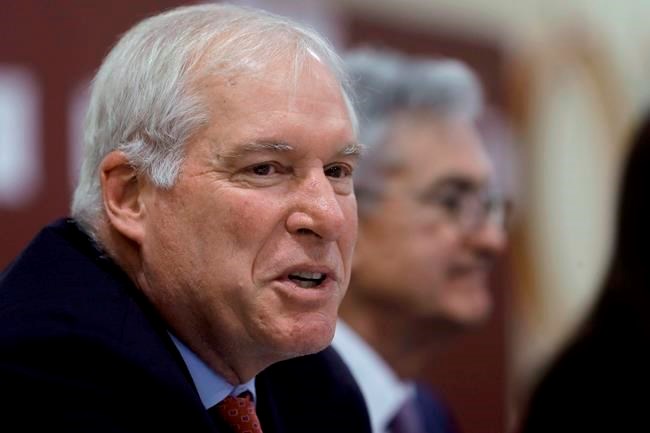WASHINGTON — Top Federal Reserve policymakers on Tuesday underscored their concern that Black and Hispanic people are sharply underrepresented in the economics field, which lessens the perspectives that economists can bring to key policy issues.
“If we don’t have a diverse group of people in the field, we won’t have the right topics to focus on,” said Eric Rosengren, president of the Federal Reserve Bank of Boston.
At a webinar sponsored by the 12 regional Fed banks, the officials and many outside economists addressed the problem on the same day that a study from the Brookings Institution reported that the top ranks of the Federal Reserve system remain disproportionately white, particularly on the boards of the regional banks.
The viral pandemic and last summer's racial justice protests have thrown a national spotlight on longstanding racial and gender disparities within the U.S. economy, with unemployment rates chronically higher for African Americans and Hispanics and levels of wealth, income and homeownership sharply lower. Yet even in that context, economics trails other fields in measures of diversity, the officials said, and the profession has been slow to address racism as a source of economic inequality.
“Race is a variable that economists are lazy about,” said Raphael Bostic, the president of the Atlanta Fed and the first Black president of a regional Fed bank in the system's 108-year history. "That means we’re drawing conclusions that are often not reflective of reality.”
In an interview, Bostic noted the Fed's adoption last summer of a new policy framework that calls for the central bank to wait for actual increases in inflation before potentially raising its benchmark interest rate. Previously, the Fed would raise rates on the expectation that inflation was poised to accelerate, even though those forecasts didn't always prove accurate.
This new framework, Bostic suggested, reflects the Fed's broadening recognition of the consequences of its policymaking.
“If you cut off the recovery because of fears of inflation, even when you haven’t seen it, you’re preventing groups of people from really fully participating in the economy,” Bostic said. “And when you look at those groups, they tend to be lower-income people, and they tend to be minorities that are the last ones to benefit.”
Ebonya Washington, an economist at Yale University, said during the webinar that just 2.8% of economics Ph.D.'s in 2019 were granted to Black students and 5.8% to Latinos. African-Americans earned more Ph.D.’s in mathematics and other scientific fields, she said.
That suggests, she said, that the problem isn't just a question of building a bigger “pipeline” of young students but of making economics more welcoming to African Americans.
“It’s not about solely changing the student to fit into the flawed profession, but let’s change the flawed profession," Washington said.
The lack of diversity results in a narrower range of research. Dania Francis, an economist at the University of Massachusetts, and Anna Gifty Opoku-Agyeman, co-founder of the Sadie Collective, a non-profit that supports Black women in economics, calculate that from 1990 through 2018 the top five economics journals published only 29 papers that explicitly addressed race and ethnicity. That was fewer than 0.5% of all papers published during that time.
Lisa Cook, an economist at the University of California, Berkeley, suggested that the lack of representation is difficult to overcome without more role models in the profession. She praised a summer program run by the American Economics Association for helping address that obstacle.
Young students who participate in the program often say, “This is the first time I've ever had ... a black woman as a professor in an economics class,” Cook said. “We’re not developing, promoting, or tenuring black women ... and that’s true for underrepresented minorities more generally.”
Participants in the webinar noted that academic economists have often been dismissive of racism as a factor in incomes, employment and other economic barometers. A result is that young minority students who are seeking solutions to racial inequalities might be discouraged from pursuing a career in economics.
“There appears to be no evidence that will get economists to admit, yes, there is discrimination, and yes it matters," said William Spriggs, chief economist at the AFL-CIO.
Spriggs and Cook have been mentioned as potential Biden administration choices for the Fed’s Board of Governors, which has one vacancy. If either were nominated and confirmed by the Senate, he or she would become just the fourth Black person to serve as a Fed governor.
The report Tuesday from the Brookings Institution pointed out that the directors of the 12 regional Federal Reserve banks, who select the banks' presidents, are mostly white men with business backgrounds.
The bank directors “are overwhelmingly white, overwhelmingly male and overwhelmingly drawn from the business communities within their districts, with little participation from minorities, women, or from areas of the economy —
Bostic suggested, though, that the Fed has made progress in the past two decades on board representation.
“We do a lot of analytics to make sure we understand what the nature of the diversity of our boards are,” he said. “That is something that we really give a lot of attention to.”
Christopher Rugaber, The Associated Press

